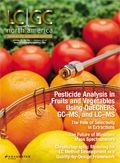Peaks of Interest
The National Institute of Standards and Technology (NIST).
National Institute of Standards and Technology Makes Polycyclic Aromatic Hydrocarbon Structure Index Publicly Available
The National Institute of Standards and Technology (NIST), an agency of the U.S. Department of Commerce, has made a polycyclic aromatic hydrocarbon (PAH) structure index database publicly available on-line (http://pah.nist.gov/). A by-product of hydrocarbon fuel combustion, PAHs can have significant adverse health and environmental impacts. The website contains data on more than 650 PAH compounds, with more to be added in the future.
According to NIST, the Chemical Informatics Research Group of NIST's Material Measurement Laboratory created the site to provide standard reference data to industry, academia, and the US public, and builds on NIST Special Publication 922: Polycyclic Aromatic Hydrocarbon Structure Index (SP922) by Lane C. Sander and Stephen A. Wise of NIST. Publication SP922 indexed a large number of PAH structures and provided parameters for estimating retention indices for liquid chromatography using a simple model. The new database expands on this by providing data from further experimental data including a collection of thermochemical data on gas-phase PAH compounds, and UV–visible spectra.
Duke Molecular Physiology Institute Receives Agilent Grant
Agilent Technologies (Santa Clara, California) has awarded a grant to the Duke Molecular Physiology Institute, Duke University (Durham, North Carolina) to support research into the metabolic and physiological aspects of major chronic diseases such as cardiovascular disease. The institute researchers perform a range of analytical chemistry techniques, including liquid chromatography and gas chromatography coupled to mass spectrometry, to characterize molecular pathways in disease.
The group is headed by Christopher Newgard, a professor at Duke University School of Medicine's Department of Pharmacology and Cancer Biology and director of the Sarah W. Stedman Nutrition and Metabolism Center and the Institute for Molecular Physiology.
"The Duke Molecular Physiology Institute seeks to combine strong genomics, epigenomics, transcriptomics, and metabolomics platforms with computational biology, clinical translation, and basic science expertise to gain new insights into the mechanisms of cardiometabolic disease," Newgard said, adding "We thank Agilent for supporting our research and look forward to collaborating to advance the understanding of cardiovascular and undiagnosed metabolic diseases."

New TRC Facility Accelerates Innovation and Delivery
April 25th 2025We’ve expanded our capabilities with a state-of-the-art, 200,000 sq ft TRC facility in Toronto, completed in 2024 and staffed by over 100 PhD- and MSc-level scientists. This investment enables the development of more innovative compounds, a broader catalogue and custom offering, and streamlined operations for faster delivery. • Our extensive range of over 100,000 high-quality research chemicals—including APIs, metabolites, and impurities in both native and stable isotope-labelled forms—provides essential tools for uncovering molecular disease mechanisms and exploring new opportunities for therapeutic intervention.
New Guide: Characterising Impurity Standards – What Defines “Good Enough?”
April 25th 2025Impurity reference standards (IRSs) are essential for accurately identifying and quantifying impurities in pharmaceutical development and manufacturing. Yet, with limited regulatory guidance on how much characterisation is truly required for different applications, selecting the right standard can be challenging. To help, LGC has developed a new interactive multimedia guide, packed with expert insights to support your decision-making and give you greater confidence when choosing the right IRS for your specific needs.

.png&w=3840&q=75)

.png&w=3840&q=75)



.png&w=3840&q=75)



.png&w=3840&q=75)










